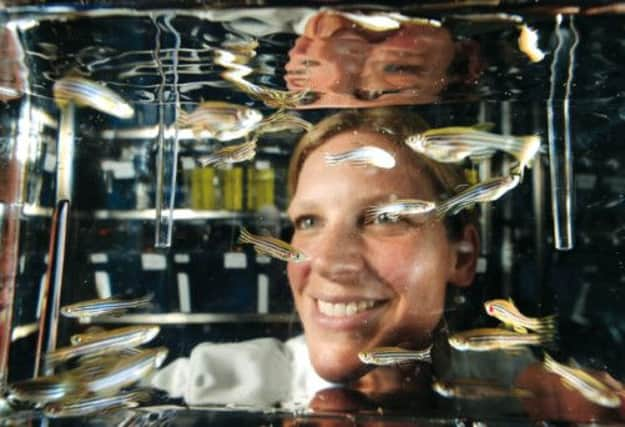Zebrafish could hold the key to drug for melanoma


Using zebrafish specially bred for the task, researchers at Edinburgh University found that removing a key gene caused malignant melanoma tumours to significantly reduce in size.
They now hope to create a drug that has the same effect in humans, destroying tumours and allowing patients to make a full recovery.
Advertisement
Hide AdAdvertisement
Hide AdThe findings were welcomed last night by health campaigners, although they stressed the need for people to be aware of the dangers from the sun to avoid cancers developing.
Around 1,200 people a year in Scotland are diagnosed with malignant melanoma, with cases up more than 50 per cent in a decade. For the latest study the researchers, from the Medical Research Council Human Genetics Unit in Edinburgh, created zebrafish whose genes could be changed by altering the water temperature.
The fish carried the same mutations in a gene known as BRAF which are found in humans with malignant melanoma. The scientists then moved their focus to another gene, called MITF, which is critical to the development of pigment cells in the skin and eyes.
The team, led by Dr Elizabeth Patton, increased the temperature of the water the fish were in so that the MITF gene was effectively “turned off” and no longer produced the proteins it normally would.
When this happened, the skin cancer tumours got smaller and disappeared. However, when the gene returned to action the tumours grew back again. The researchers also discovered that tumours only shrunk when the gene was removed completely. Simply reducing MITF levels caused the cancers to develop further, making it worse.
“When we take the gene away by turning up the temperature of the water, the tumour completely regresses. To me that is a really exciting finding,” Patton said. “In the context of melanoma where people are really ill, it’s a really interesting target to look at.”
To have the same effect in human patients, Patton said a drug would be required to target the MITF gene and shrink tumours.
She said: “We have shown using genetics that this is possible in an animal – that you can make a melanoma and you can make it go away by targeting this gene. It gets us excited about trying to screen for drugs that would target MITF. We have started a screening programme in the lab based on this to try to target this gene.”
Advertisement
Hide AdAdvertisement
Hide AdPatton said that while targeting the MITF gene seemed like a good idea, it may not kill all of the tumour which was why it grew back when levels were increased again. She said further work was needed to investigate this.
“There may be a series of stem cells left and that is our next exciting area to study,” she said. “Why does it come back after it has been taken away?”
Previous research has found that the BRAF gene plays a key role in melanoma development, making it a target for new drugs. But Patton said targeting MITF in tandem may have the greatest impact for patients. “Melanomas can also come back so we really need to think about multiple drugs to target melanoma,” she said.
“I would see, in the long-term, targeting MITF as one of the pieces of the puzzle, one of the parts of the drugs cocktail.” Zebrafish are a useful tool for scientists as their genetic make-up has been mapped and is very similar to humans.
“Many of the key cancer genes found in humans are also found in zebrafish,” Patton said. “The ability to alter their genes quite easily is important. The other thing that is important is as they are fertilised outside the mother as eggs, we can follow their development under the light microscope from a single cell.”
The researcher said this was an key tool as there were links between embryonic development and the development of cancer, adding: “So not only do the cancer genes and the cancers themselves have similarity with humans, but you get this added benefit that you can really study the gene in development and where it goes wrong in cancer development.
Leigh Smith, from charity Melanoma Action and Support Scotland, welcomed the new research, published in the Journal of Investigative Dermatology.
“This is another step forward and this is what the research is all about – learning what’s going wrong with the body’s control system so we can deal with the problems with most cancers,” she said.
Advertisement
Hide AdAdvertisement
Hide Ad“I don’t doubt that melanoma is the same and so we welcome every step forward.”
But while potential new treatments were welcomed, Smith said it was vital people reduced their risk by staying safe in the sun.
Twitter: @LyndsayBuckland